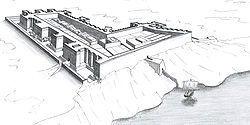
Semna (Nubia)
Encyclopedia

Senusret I
Senusret I was the second pharaoh of the Twelfth Dynasty of Egypt. He ruled from 1971 BC to 1926 BC, and was one of the most powerful kings of this Dynasty. He was the son of Amenemhat I and his wife Nefertitanen. His wife and sister was Neferu. She was also the mother of the successor Amenemhat II...
(1965-1920 BC) on the west bank of the Nile
Nile
The Nile is a major north-flowing river in North Africa, generally regarded as the longest river in the world. It is long. It runs through the ten countries of Sudan, South Sudan, Burundi, Rwanda, Democratic Republic of the Congo, Tanzania, Kenya, Ethiopia, Uganda and Egypt.The Nile has two major...
at the southern end of a series of fortresses founded during the 12th Dynasty
Twelfth dynasty of Egypt
The twelfth dynasty of ancient Egypt is often combined with Dynasties XI, XIII and XIV under the group title Middle Kingdom.-Rulers:Known rulers of the twelfth dynasty are as follows :...
(1985-1795 BC) in the second-cataract
Cataracts of the Nile
The cataracts of the Nile are shallow lengths of the Nile between Aswan and Khartoum where the surface of the water is broken by many small boulders and stones protruding out of the river bed, as well as many rocky islets. Aswan is also the Southern boundary of Upper Egypt...
area of Lower Nubia
Nubia
Nubia is a region along the Nile river, which is located in northern Sudan and southern Egypt.There were a number of small Nubian kingdoms throughout the Middle Ages, the last of which collapsed in 1504, when Nubia became divided between Egypt and the Sennar sultanate resulting in the Arabization...
. The Semna gorge, at the southern edge of ancient Egypt, was the narrowest part of the Nile valley. It was here, at this strategic location, that the 12th Dynasty pharaohs built a cluster of four mud-brick fortresses: Semna, Kumma
Kumma
Kumma is a village in Kehtna Parish, Rapla County in northern-central Estonia....
, Semna South and Uronarti
Uronarti
Uronarti was an ancient Egyptian settlement located on an island in the Nile above the Second Cataract. It is well known for its triangular-shaped fortress, constructed between the reigns of Middle Kingdom rulers Senusret I and Senusret III, in the nineteenth century BCE...
(all covered by the waters of Lake Nasser
Lake Nasser
Lake Nasser is a vast reservoir in southern Egypt, and northern Sudan, and is one of the largest man-made lakes in the world. Strictly, "Lake Nasser" refers only to the much larger portion of the lake that is in Egyptian territory , with the Sudanese preferring to call their smaller body of water...
since the completion of the Aswan High Dam in 1971). The rectangular Kumma fortress, the L-shaped Semna fortress (on the opposite bank) and the smaller square fortress of Semna South were each investigated by the American archaeologist George Reisner
George Reisner
-References:* * "Reisner, George Andrew." Encyclopædia Britannica. 2005. Encyclopædia Britannica Online. 11 Nov. 2005 .-External links:...
in 1924 and 1928. Semna and Kumma also included the remains of temples, houses and cemeteries dating to the New Kingdom (1550-1069 BC), which would have been roughly contemporary with such lower Nubian towns as Amara
Amara
Amara, the sun beetles, are a large genus of carabid beetles, mostly holarctic, but a few species are neotropical or occurring in eastern Asia.These ground beetles are mostly black or bronze-coloured...
West and Sesebisudla, when the second cataract region had become part of an Egyptian 'empire', rather than simply a frontier zone.
The fort had several advanced features - the mudbrick walls were reinforced with logs, there were doubly fortified gates, there was a fortified corridor down to the Nile allowing ready access to water supplies. The logs increased the vulnerability to fire and traces of fires can be seen in the walls.

